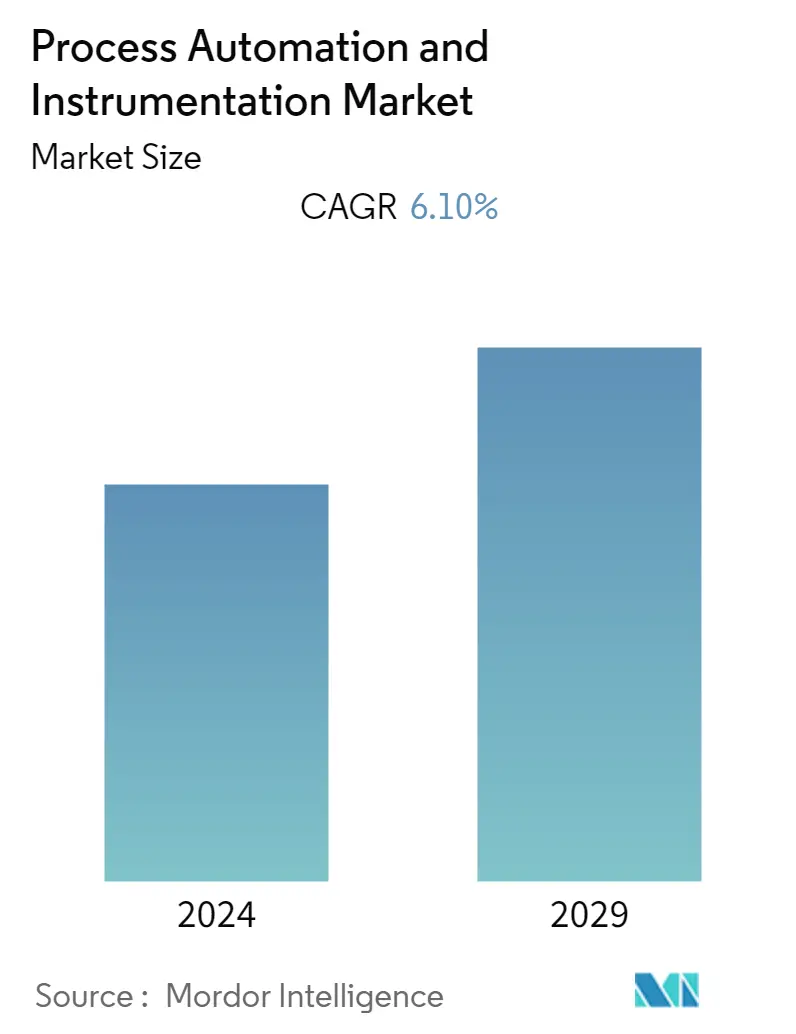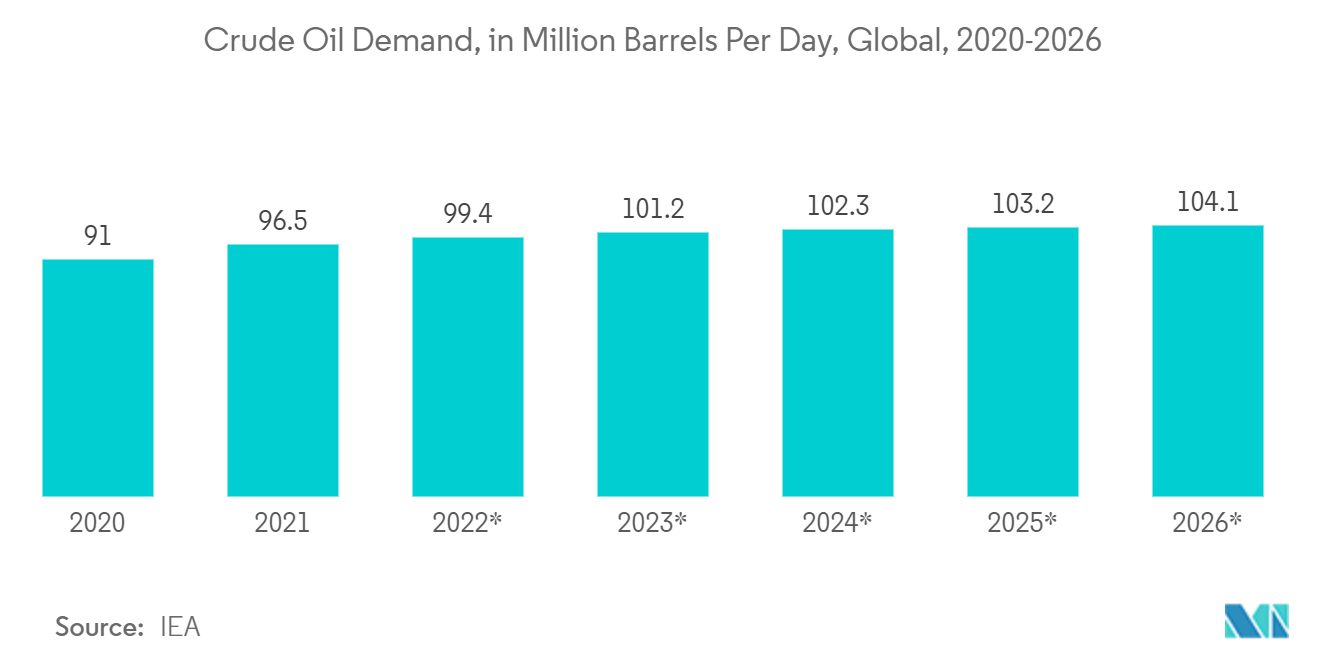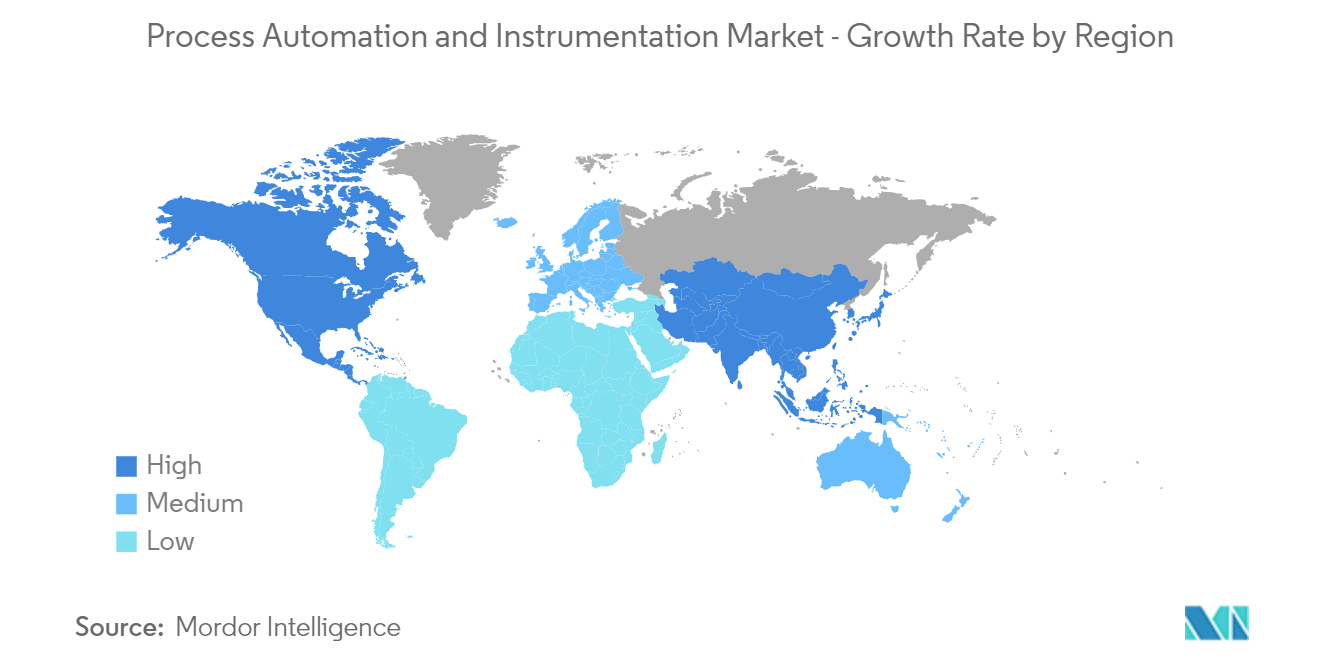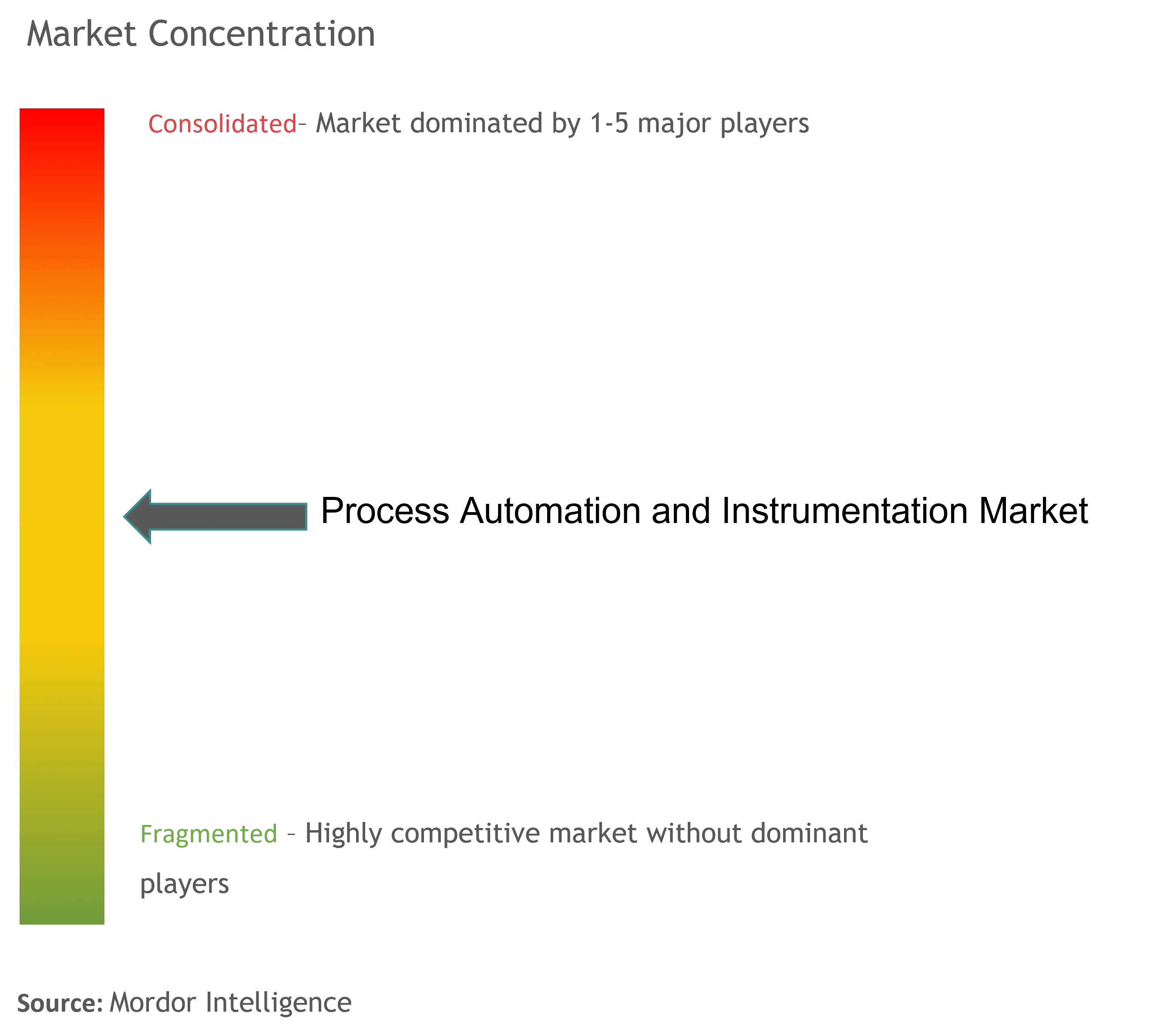Process Automation & Instrumentation Market Size

| Study Period | 2019 - 2029 |
| Base Year For Estimation | 2023 |
| CAGR | 6.10 % |
| Fastest Growing Market | Asia Pacific |
| Largest Market | North America |
| Market Concentration | Medium |
Major Players
*Disclaimer: Major Players sorted in no particular order |
Process Automation & Instrumentation Market Analysis
The process automation and instrumentation market is expected to grow at a CAGR of 6.1% over the forecast period. The growing adoption of digital technologies like AI, IIoT, and machine learning, along with the ever-increasing emphasis on industrial automation, are among the significant factors contributing to the growth of the process automation and instrumentation market. Furthermore, the increasing importance of cost optimization, increased productivity, energy efficiency, better scalability, and reduced errors support the studied market's growth.
- The automation industry has been revolutionized by combining the digital and physical aspects of manufacturing to deliver optimum performance. Further, the focus on a shorter time to market and achieving zero waste production has augmented the market's growth for process automation and instrumentation used across the processing industries.
- Automation of manufacturing processes has offered various benefits, such as effortless monitoring, waste reduction, and production speed. Connecting the industrial machinery and equipment and obtaining real-time data have played a vital role in the adoption of SCADA, HMI, PLC systems, and software that offer visualization; this enables reducing the faults in the product, reducing downtime, scheduling maintenance, and switching from being in the reactive state to predictive and prescriptive stages for decision-making.
- According to a survey about the adoption of automation solutions by Onpassive, an AI tech company that builds fully autonomous products, it was discovered that a significant number of companies nowadays are boosting their use of intelligent automation and RPA. In responding to the survey, about 58% of CEOs stated that they have started automating. In particular, about 35% reported that they are experimenting, 13% said that they are deploying, and 8% reported that they are automating at scale. Such trends create a favorable scenario for the growth of the studied market.
- While the instruments such as physical control valve assembly have changed little over the years, the technology surrounding these valves has advanced significantly. Increased capabilities to gather digital intelligence in real-time will only continue to enable improvements in control valve automation moving forward. Combined with the newest intelligent digital control valve positioners and cutting-edge electric valve actuators, control valve automation is on an upward wave that is anticipated to benefit all modern process plants.
- However, process automation is costly, as it requires a significant upfront investment to upgrade the overall infrastructure, including machinery, IT, etc. Hence, the high initial investment coupled with high operational and maintenance costs prevents small and medium-sized enterprises from adopting process automation and instrumentation processes, which is among the significant factor challenging the studied market's growth.
- A notable impact of COVID-19 has been observed on the growth of the studied market, as the widespread lockdown imposed, especially during the initial phase, significantly disrupted the supply chain and the operation of the industrial sector, creating a slowdown in demand for the studied market. However, the pandemic has dramatically enhanced awareness about the benefits of digital technologies, which is expected to drive investments in automation, and advanced instrumentation solutions, creating growth opportunities in the studied market.
Process Automation & Instrumentation Market Trends
This section covers the major market trends shaping the Process Automation & Instrumentation Market according to our research experts:
Oil and Gas Industry to Hold Significant Market Share
- As the oil and gas industries process a variety of hazardous substances that are also exposed to harsh environments and operational environments, any explosions or catastrophic event can endanger the safety of humans and the environment. Process automation and instrumentation provide monitoring and control essential for ensuring human resources' safety and compliance with environmental regulations. When integrated into automation systems, processing instruments, such as smart control valves, also helps manufacturers increase productivity and product consistency by delivering continuous data regarding end-product quality and process efficiency.
- Furthermore, in the oil and gas industry, protecting a pressurized pipeline from corrosion and leaks and minimizing downtime are among the crucial responsibilities of the industry. According to the NACE (National Association for Corrosion Engineers), the oil and gas industry suffers a cost of over USD 1.6 billion per year due to corrosion alone. The presence of oxygen in the gas sample determines that there is a leak in the pressurized pipeline system. The adoption of advanced process control and automation instrumentations, along with analytical instruments, can help the operators significantly reduce this cost.
- Furthermore, advanced automation can significantly reduce energy utilization in all areas of the oil and gas industry, including process units, utilities, and offsite units. Energy is the single largest controllable cost for most oil and gas refineries, often comprising more than 50% of non-crude operating expenses. Further, the increase in operational costs has caused most refineries to look even more closely at their energy utilization, creating growth opportunities for the studied market.
- The increasing global consumption of oil and gases are driving oil-producing companies to increase their production and investment to explore new oil fields and extraction zones which is expected to create a supportive growth environment for the studied market. According to the IEA, the global demand for crude oil is expected to reach 104.1 million barrels per day by 2026, from 91 million barrels per day in 2020.

North America is Expected to hold a Significant Market Share
- North America is one of the largest global markets for process automation and instrumentation. The United States is renowned for its innovation capabilities and is at the forefront of prominent developments surrounding the emerging technologies of the Fourth Industrial Revolution. New-found shale resources in the United States, and an increasing number of oil and gas projects in Canada, are additional indicators of the market potential.
- For instance, the Canadian Association of Energy Contractors (CAOEC) organization, which represents Canada's oil and gas drilling sector, expects more activity in 2023. The organization expects 6,409 wells to be drilled in Canada in 2023, an approximately 15% increase from 2022. As process automation and instrumentations, such as control valves, PLCs, etc., are widely used in upstream, downstream, and midstream activities, such trends are expected to support the studied market's growth.
- Industrial automation in the North American region, especially in the United States, is expected to exhibit strong growth, as the recent government initiatives to push the local industries amid its ongoing disputes with China are expected to favor the growth of the manufacturing sector in the country. This is evident from the growing investment in industrial robots and other automation technologies. For instance, according to the Association for Advancing Automation (A3), during the period January to September 2022, North American companies purchased 35,804 units of industrial robots, valued at USD 1.875 billion, up 24% for ordered units and 27% for revenue over the same period in 2021.
- For seeking the growth opportunity with a rapid increase in the adoption of process automation solutions, companies in the region are continuously expanding their presence and product portfolio for the studied market. For instance, in August 2022, FANUC America, a supplier of CNCs, robotics, and ROBOMACHINEs, announced an expansion of its West Campus that would expand its operational space in Oakland County to nearly about two million square feet. According to the company, the expansion plan involves the construction of a 655,000-square-foot facility to house manufacturing, R&D, and engineering projects.

Process Automation & Instrumentation Industry Overview
The market for process automation and instrumentation is moderately fragmented, with the presence of many key players operating in the segment with almost similar market presence globally. Also, the market ecosystem is subjected to high initial costs and high competition from established players, including ABB, Honeywell, and Rockwell Automation, among others, increasing the barrier for new entrants into the market. In November 2022, ABB Measurement & Analytics opened its first smart instrumentation factory in Bangalore, India. According to the company, the new plant will manufacture field devices such as temperature and pressure transmitters, IP converters, and electromagnetic flowmeters for various industries, including power, pharmaceutical, oil and gas, water, and other segments. In August 2022, the OPC Foundation (OPCF) and the FieldComm Group (FCG) announced a collaboration to drive multi-vendor interoperability of OPC UA-based instrumentation devices and the extensions for the field level, named OPC UA FX (Field eXchange). This development is aimed at providing an interoperable interface between PLC / DCS and instrumentation devices, such as actuators, transmitters, and instruments.
Process Automation & Instrumentation Market Leaders
-
ABB Limited
-
Rockwell Automation, Inc
-
Emerson Electric Co.
-
Honeywell International, Inc.
-
Schneider Electric SE
*Disclaimer: Major Players sorted in no particular order

Process Automation & Instrumentation Market News
- August 2022 - Andhra Paper Limited (APL), a leading Indian integrated pulp and paper manufacturer, deployed an ABB advanced process control (APC) solution at their Rajahmundry mill's lime kiln. To help the company reduce energy requirements, ABB integrated their OPT800 Lime APC solution into APL's existing ABB Ability System 800xA distributed control system (DCS).
- January 2022 - ExxonMobil selected Yokogawa Electric Corporation as the system integrator for the first-ever field trial of an Open Process Automation system designed to operate an entire production facility. According to the company, the field trial will take place at an ExxonMobil manufacturing facility located on the U.S. Gulf Coast, replacing the existing distributed control system (DCS) and programmable logic controllers (PLC) with a single, integrated system that meets the Open Process Automation Standard (O-PAS).
Process Automation & Instrumentation Market Report - Table of Contents
1. INTRODUCTION
- 1.1 Study Assumptions and Market Definition
- 1.2 Scope of the Study
2. RESEARCH METHODOLOGY
3. EXECUTIVE SUMMARY
4. MARKET INSIGHTS
- 4.1 Market Overview
- 4.2 Industry Value Chain Analysis
-
4.3 Industry Attractiveness - Porter Five Forces
- 4.3.1 Threat of New Entrants
- 4.3.2 Bargaining Power of Buyers
- 4.3.3 Bargaining Power of Suppliers
- 4.3.4 Threat of Substitute Products
- 4.3.5 Intensity of Competitive Rivalry
- 4.4 Impact of COVID-19 on the Market
5. MARKET DYNAMICS
-
5.1 Market Drivers
- 5.1.1 Importance of Energy Efficiency and Cost Reduction
- 5.1.2 Increasing Adoption of IIoT Solutions
-
5.2 Market Restraints
- 5.2.1 High Investment for Implementation and Significant Maintenance Cost for Process Automation and Instrumentation Solutions
6. MARKET SEGMENTATION
-
6.1 By Instrument
- 6.1.1 Field Instruments
- 6.1.2 Control Valve
- 6.1.3 Analytical Instruments
-
6.2 By Solution
- 6.2.1 Advanced Process Control (APC)
- 6.2.2 Distributed Control System (DCS)
- 6.2.3 Human Machine Interaction (HMI)
- 6.2.4 Manufacturing Execution System (MES)
- 6.2.5 Programmable Logic Controller (PLC)
- 6.2.6 Safety Automation
- 6.2.7 Supervisory Control and Data Acquisition (SCADA)
-
6.3 By End-user Industry
- 6.3.1 Oil and Gas
- 6.3.2 Food and Beverage
- 6.3.3 Pharmaceutical and Biopharma
- 6.3.4 Chemical and Petrochemical
- 6.3.5 Other End-user Industries
-
6.4 By Geography
- 6.4.1 North America
- 6.4.2 Europe
- 6.4.3 Asia Pacific
- 6.4.4 South America
- 6.4.5 Middle East and Africa
7. COMPETITIVE LANDSCAPE
-
7.1 Company Profiles
- 7.1.1 ABB Ltd
- 7.1.2 Emerson Electric Co.
- 7.1.3 Honeywell International, Inc.
- 7.1.4 Mitsubishi Electric
- 7.1.5 Rockwell Automation, Inc.
- 7.1.6 Schneider Electric SE
- 7.1.7 Siemens AG
- 7.1.8 Yokogawa Electric Corporation
- 7.1.9 General Electric Company
- 7.1.10 Eaton Corporation
- *List Not Exhaustive
8. INVESTMENT ANALYSIS
9. FUTURE OUTLOOK OF THE MARKET
** Subject To AvailablityProcess Automation & Instrumentation Industry Segmentation
Process automation and instrumentation process involve careful monitoring of various business-specific production processes. This technology-enabled automation and instrumentation of complex business processes help industrial organizations streamline the business towards achieving organizational goals, achieve process efficiency, improve quality and reduce operational costs.
The process automation and instrumentation market study has considered various industrial instruments used in process industries for control, monitoring, and analyzing the process. Also, the automation solution offered by vendors such as HMI, MES, PLC, and safety automation, among others, for the application in a wide range of end-user industries across the globe. The study also covers the impact analysis of COVID-19 on the market at a global scale. The market sizes and forecasts are provided in terms of value (USD million) for all the above segments.
| By Instrument | Field Instruments |
| Control Valve | |
| Analytical Instruments | |
| By Solution | Advanced Process Control (APC) |
| Distributed Control System (DCS) | |
| Human Machine Interaction (HMI) | |
| Manufacturing Execution System (MES) | |
| Programmable Logic Controller (PLC) | |
| Safety Automation | |
| Supervisory Control and Data Acquisition (SCADA) | |
| By End-user Industry | Oil and Gas |
| Food and Beverage | |
| Pharmaceutical and Biopharma | |
| Chemical and Petrochemical | |
| Other End-user Industries | |
| By Geography | North America |
| Europe | |
| Asia Pacific | |
| South America | |
| Middle East and Africa |
Process Automation & Instrumentation Market Research FAQs
What is the current Process Automation and Instrumentation Market size?
The Process Automation and Instrumentation Market is projected to register a CAGR of 6.10% during the forecast period (2024-2029)
Who are the key players in Process Automation and Instrumentation Market?
ABB Limited, Rockwell Automation, Inc, Emerson Electric Co., Honeywell International, Inc. and Schneider Electric SE are the major companies operating in the Process Automation and Instrumentation Market.
Which is the fastest growing region in Process Automation and Instrumentation Market?
Asia Pacific is estimated to grow at the highest CAGR over the forecast period (2024-2029).
Which region has the biggest share in Process Automation and Instrumentation Market?
In 2024, the North America accounts for the largest market share in Process Automation and Instrumentation Market.
What years does this Process Automation and Instrumentation Market cover?
The report covers the Process Automation and Instrumentation Market historical market size for years: 2019, 2020, 2021, 2022 and 2023. The report also forecasts the Process Automation and Instrumentation Market size for years: 2024, 2025, 2026, 2027, 2028 and 2029.
Process Automation & Instrumentation Industry Report
Statistics for the 2024 Process Automation & Instrumentation market share, size and revenue growth rate, created by Mordor Intelligence™ Industry Reports. Process Automation & Instrumentation analysis includes a market forecast outlook 2029 and historical overview. Get a sample of this industry analysis as a free report PDF download.



